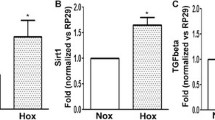Abstract
Alterations in osteoblast metabolism are involved in the pathogenesis of typical subchondral bone changes in osteoarthritis (OA). Osteocalcin is a specific bone protein, synthesised by the osteoblasts, which can be considered a marker of metabolic activity of these cells. In this study we correlated osteocalcin production from human osteoblasts isolated from healthy and osteoarthritic subjects to the degree of cartilage damage, before and after stimulation with 1,25(OH)2-vitamin D3, the active metabolite of vitamin D3. We isolated human osteoblasts from cancellous bone of healthy subjects and from subchondral bone of osteoarthritic subjects and considered the osteoblasts corresponding to different degrees of cartilage damage as different cell populations. We determined the osteocalcin production in normal and osteoarthritic osteoblasts from maximal and minimal cartilage damage areas both under basal conditions and after vitamin D3 stimulation. Compared to normal osteoblasts, under basal conditions osteocalcin production is significantly greater in osteoarthritic osteoblasts, corresponding both to maximal and minimal damage joint areas. No differences were observed between osteoblasts from maximal and minimal damage areas. The response of osteoblasts to vitamin D3 stimulation appeared to be proportional to the degree of joint damage, as the vitamin D3-induced increase in osteocalcin is proportionally greater in maximally damaged osteoblasts compared to minimally damaged ones. Thus, after vitamin D3 stimulation, a significant increase in osteocalcin production by maximally damaged osteoblasts compared to the minimally damaged ones was observed. This study confirms abnormal osteoarthritic osteoblast behaviour and indicates that osteoblasts from different areas of the same affected joint may be metabolically different, supporting the hypothesis that subchondral osteoblasts may play an essential role in the pathogenesis of OA.


Similar content being viewed by others
References
Carlson CS, Loeser RF, Jayo MG, Weaver DS, Jerome CP (1994) Osteoarthritis in cynomolgus macaques: a primate model of naturally occurring disease. J Orthop Res 12:331–339
Carlson CS, Loeser RF, Purser MJ, Gardin JF, Jerome CP (1993) Osteoarthritis in cynomolgus macaques. III: effects of age, gender and subchondral bone thickness on the severity of disease. Bone Miner Res 11:1209–1217
Dequeker J, Mohan S, Finkelman RD, Aerssens J, Baylink DJ (1993) Generalised osteoarthritis associated with increased insulin-like growth factor types I and II and transforming growth factor β in cortical bone from the iliac crest. Possible mechanism of increased bone density and protection against osteoporosis. Arthritis Rheum 36:1702–1708
Raymaekers G, Aerssens J, Van den Eynde R, Peeters J, Geusens P, Devos P, et al. (1992) Alterations of the mineralisation profile and osteocalcin concentrations in osteoarthritic cortical iliac crest bone. Calcif Tissue Int 51:269–275
Lajeunesse D, Busque L, Ménard P, Brunette MG, Bonny Y (1996) Demonstration of an osteoblast defect in two cases of human malignant osteoporosis: correction of the phenotype after bone marrow transplant. J Clin Invest 98:1835–1842
Hilal G, Martel-Pelletier J, Pelletier JP, Lajeunesse D (1998) Osteoblast-like cells from human subchondral osteoarthritic bone demonstrate an altered phenotype in vitro. Possible role in subchondral bone sclerosis. Arthritis Rheum 41:891–899
Lajeunesse D, Hilal G, Pelletier JP, Martel-Pelletier J (1999) Subchondral bone morphological and biochemical alterations in osteoarthritis. Osteoarthritis Cartilage 7:321–322
Altman E, Asch D, Bloch G, Bole D, Borenstein K, et al. (1986) Development of criteria for the classification and reporting of osteoarthritis: classification of osteoarthritis of the knee. Arthritis Rheum 29:1039–1049
Zambonin G, Colucci S, Cantatore FP, Grano M (1998) Response of human osteoblasts to polymethylmetacrylate in vitro. Calcif Tissue Int 62:362–365
Mansell JP, Bailey AJ (1998) Abnormal cancellous bone collagen metabolism in osteoarthritis. J Clin Invest 101:1596–1603
Mansell JP, Tarlton JF, Bailey AJ (1997) Biochemical evidence for altered subchondral bone metabolism in osteoarthritis of the hip. Br J Rheumatol 36:16–19
Van Beuningen HM, van der Kraan, Arntz JO, van der Berg W (1994) Transforming growth factor-β1 stimulates articular chondrocyte proteoglycan synthesis and induces osteophyte formation in murine knee joint. Lab Invest 71:279–290
Dieppe P, Cushnaghan J, Young P, Kirwan J (1993) Prediction of the progression of joint space narrowing in osteoarthritis of the knee by bone scintigraphy. Ann Rheum Dis 52:557–563
Martinez ME, Sanchez-Cabezudo MJ, Moreno I, Garcez MV, Munuera L (1999) Influence of skeletal site of origin and donor age on 1,25(OH)2D3-induced response of various osteoblastic markers in human osteoblastic cells. Bone 24:203–209
Ingle BM, Hay SM, Bottjer HM, Eastell R (1999) Changes in bone mass and bone turnover following distal forearm fracture. Osteoporos Int 10:399–407
Martinez ME, Del Campo MT, Medina S, Sanchez M, Sanchez-Cabezudo MJ, Esbrit P, et al. (1999) Influence of skeletal site of origin and donor age on osteoblastic cell growth and differentiation. Calcif Tissue Int 64:280–286
Gunderberg CM, Looker AC, Nieman SD, Calvo MS (2002) Patterns of osteocalcin and bone specific alkaline phosphatase by age, gender, race or ethnicity. Bone 31:703–708
Vanderschueren D, Gevers G, Raymaekers G, Devos P, Dequeker J (1990) Sex and age-related changes in bone and serum osteocalcin. Calcif Tissue Int 46:179–182
Yasumizu T, Okuno T, Fukada Y, Hoshi K (2000) Age-related changes in bone mineral density and serum-bone-related proteins in premenopausal and postmenopausal Japanese women. Endocr J 47:103–109
Westacott CI, Webb GR, Warnok MG, Sims JV, Elson CJ (1997) Alteration of cartilage metabolism by cells from osteoarthritic bone. Arthritis Rheum 40:1282–1291
Milgram JV, Jasty M (1982) Osteopetrosis—a morphological study of twenty-one cases. J Bone Joint Surg Am 64:912–929
Dequeker J (1997) Inverse relationship of interface between osteoporosis and osteoarthritis. J Rheumatol 24:795–798
Dequeker J, Luyten FP (2003) Bone mass and osteoarthritis. Clin Exp Rheum 18 [Suppl 21]:S21-S26
Geusens P, Vanderschueren D, Verstraeten A, Dequeker J, Devos P, Bouillon R (1991) Short-term course of 1,25(OH)2D3 stimulates osteoblasts but not osteoclasts in osteoporosis and osteoarthritis. Calcif Tissue Int 49:168–173
Acknowledgements
This study was supported by a grant from the University of Foggia (ex 60% 2001)
Author information
Authors and Affiliations
Corresponding author
Rights and permissions
About this article
Cite this article
Cantatore, F.P., Corrado, A., Grano, M. et al. Osteocalcin synthesis by human osteoblasts from normal and osteoarthritic bone after vitamin D3 stimulation. Clin Rheumatol 23, 490–495 (2004). https://doi.org/10.1007/s10067-004-0928-1
Received:
Accepted:
Published:
Issue Date:
DOI: https://doi.org/10.1007/s10067-004-0928-1




